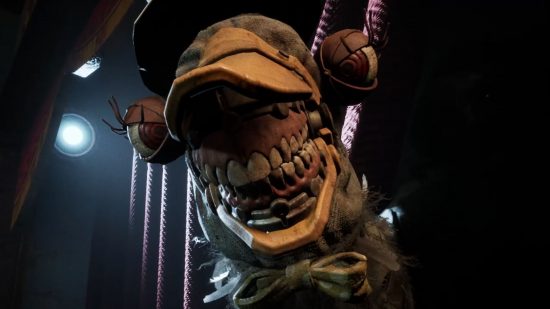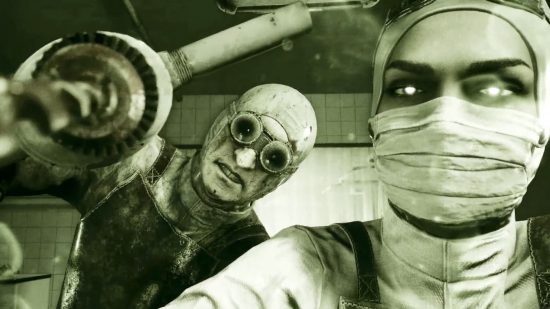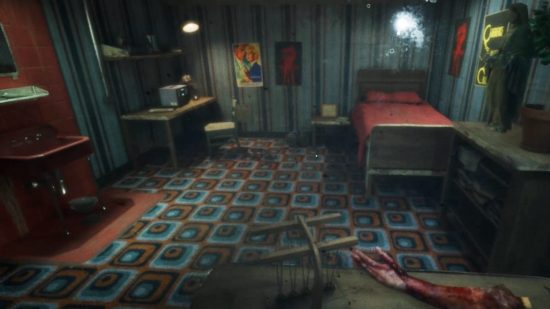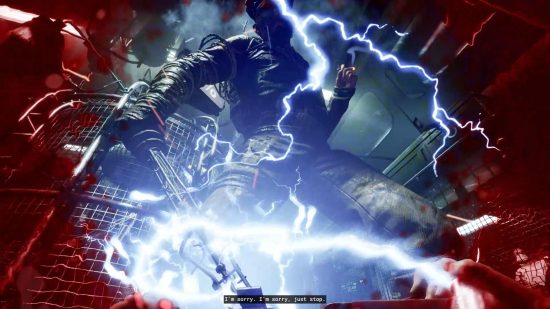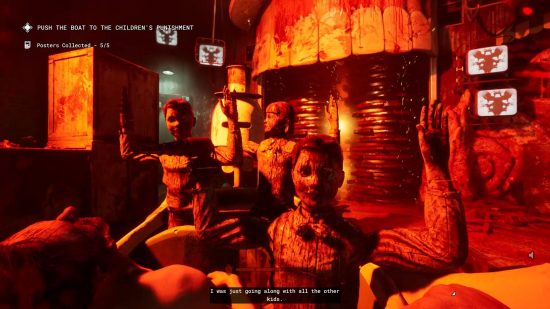Are you lost? Lonely? Confused? Well, the Murkoff Corporation wants you. PCGamesN got the opportunity to attend The Outlast Trials preview event with Red Barrels co-founder Philippe Morin and game director Alex Charbonneau, to glean some insight into the development of the horror game ahead of its release date, as well as their plans for early access. Later, we went hands-on as one of the Murkoff Corporation’s unfortunate test subjects – otherwise known as Reagants – both alone and with friends. Here’s what we learned.
The Outlast Trials takes us back to where it all began, during the height of the Cold War and the brainwashing scare. To escape the anxieties of the Red Scare, regular folks down on their luck can sign up to be whisked away to a secret facility that promises the world. Enduring fans of the series will instantly recognize all the hallmarks of the Murkoff Corporation, the shady company responsible for the twisted machinations that unfold within the Outlast series.
The Outlast Trials employs the sensationalized, pop culture version of MK-Ultra as depicted in The Manchurian Candidate. While it would be remiss not to acknowledge the atrocities committed over the course of the actual MK-Ultra program, The Outlast Trials is clearly not making a bid for historical reality. Instead, Red Barrels has taken clear inspiration from the likes of Rob Zombie’s 31 and Saw, to deliver a horror escape room experience thick with viscera, mannequin props, and dicks. So many dicks.
The enduring presence of guards and scientists at every turn is a nice touch. Rather than reducing them to moving props that sit on the boundaries of each area, Red Barrels has imbued Murkoff staff with a degree of interiority via fleeting snippets of dialogue that capture the everyday mundanity of the regular workplace.“You always have this duality,” Morin explains. “We always have people above watching as you perform a task.”
However, for the first time in the Outlast series, you won’t be forced to experience the horrors alone – you can bring up to three other friends along with you. “When you play with three to four players, it’s complete chaos,” Charbonneau grins. “It’s still very scary, but nothing goes according to plan.” The eponymous trials are spread across different hangars that function as enormous sets, such as a police station, theme park, and orphanage. Each trial has a rough three-act structure that tasks me with working towards a relatively simple goal – such as starting a generator, or fishing a key out of a corpse – made complicated by the obstacle of a villain or two. The final set piece peels away the hide-and-seek act and transitions into the enduring experience of Outlast: a mad dash throughout the level I’ve just crept around, desperately trying to outmaneuver my pursuer.
As a single-player experience, The Outlast Trials leaves me strikingly ambivalent. While many players are likely looking for the latest spooky multiplayer game to play with friends, the viability of flying solo as a Murkoff test subject was a huge draw for me. “If you play solo, it’s the same kind of scary game as Outlast was before,” says Charbonneau, and it’s true. My time alone with The Outlast Trials was largely spent on tenterhooks, creeping from one hiding spot to the other, and letting the oppressive atmosphere of the Murkoff Facility’s environments worm their way under my skin. Without the reassuring voices of my friends to drown it out, the sound design of The Outlast Trials takes front and center, characterized by a soundscape of bass distortions, violin strings, and of course, the heavy tread of someone primed to rip me limb from limb.
However, I was brought up short by the first trial’s final objective: to execute a snitch via an electric cage. Getting the unlucky fella into position was easily done, but to activate the current, I had to hold down a lever to charge it. On each attempt, I’d barely get my hands on it before an enemy was charging toward me, and I’d have to abandon my post to give them the slip. The progress I made in these final moments was slow, arduous, and all for nothing. As I was ferried back to the sleep room nursing my failure right at the eleventh hour, I couldn’t help but think that this situation would have been far less painful with another person on hand – a hypothesis later proven when I later succeeded the same trial with a friend in tow.
Instead of filling me with frustration and the sense that I’d just wasted my time, this second attempt was a pulse-pounding, exhilarating experience as we traded off drawing the warden’s ire. This dramatic and extended chase sequence fully captured the spirit of the high-octane set pieces in previous entries in the series, made more terrifying due to the free-form nature of The Outlast Trials’ environments. I also get to experience the trial in an entirely new way, during the mad dash back to the shuttle, a final, thrilling adrenaline high of throwing caution to the wind.
Beyond the trials, The Outlast Trials’ hub area is a sleep room populated by NPCs that provide upgrades and unlockable abilities, but it also serves as an area for players to take stock. When I enter my cell for the first time, a genial disembodied voice delivers a Full Metal Jacket reference over the sleep room’s tannoy: “This is your cell. There are many like it, but this one’s yours.” This is where the bulk of player customization lives, allowing me to spend currency I earn from completing trials on cosmetics for both my cell and myself. I’m not convinced that The Outlast Trials really needs any of this to sustain its gameplay loop, and it seems to go against the survival game’s conceit – after all, if the purpose of the eponymous trials is to force you to cast off your identity and succumb to milieu control, a space to express yourself seems counterproductive.
On the other hand, my co-op partner and I excitedly raced off to our cell after each trial, and delighted in kitting out our grotty digs with the latest cosmetics we unlocked, with the sole purpose of inviting each other around for a rancid show-and-tell. While I opted for a tin of coffee, a typewriter, and floral wallpaper, my co-op partner left a tray of donuts and a sex toy in pride of place below her ‘70s-inspired cell window. Eurgh.
The Outlast series is famed for its memorable bosses and their grotesque personalities – what Morin refers to as “Outlast DNA” – and this tradition continues in this latest installment. The bosses in The Outlast Trials patrol throughout their stationed trials, each equipped with a rolodex of ridiculous one-liners and a bad attitude. They’re so campy, often painting a visceral picture of what they’re going to do to me as I sneak around them. My first glimpse of the warden in the police station includes him grabbing his crotch and engaging in a bout of erotic electrostimulation with his stun baton. Over the course of my time avoiding him, he casually called me a “fucko” and electrocuted a man to death while screaming, “We got fuckin’ laws around here!” The Outlast Trials community memes truly do write themselves.
These trial bosses are joined by a colorful rogues’ gallery of reappearing enemies, each imbued with their own personality. Morin’s favorite, The Pusher, is a wiry, gibbering chemist who inflicts psychosis with a maniacal shriek once he captures me. While drugged, I encounter the Skinner Man, a phantom that terrorizes me with a barrage of jumpscares and damage over time. However, the enemies that stole the show were the clones of different co-op partners that would occasionally stalk me through the map. While I could generally identify them by their corrupted username, there were a few occasions where I excitedly ran up to a teammate with a med kit, only for them to stab me in the abdomen instead. Charming.
The trials are full of enemies, but also possibilities. There are plenty of items at my disposal, from med kits, antidotes, lockpicks, and throwable objects. They’re also clearly designed with the intention to be played repeatedly, which imbues The Outlast Trials with a longevity that will easily carry it to launch. My first attempt at a trial lasted well over an hour and a half, and largely consisted of stumbling blindly through the unknown. Subsequent attempts saw me striking out with a degree of confidence in the right direction, and resulted in shorter innings and a higher grade.
Outlast 2’s maps were so large that navigating them could easily become an exercise in frustration. In The Outlast Trials, Red Barrel has struck a fine balance between leaving me disoriented, but not entirely lost. Diegetic signposting is everywhere and often on the nose, and if all else fails, there’s plenty of memorable landmarks to get me and my co-op partner on the right track – simply turn right at the pair of immolated corpses engaged in autofellatio, keep going past the plastic dog sitting in a bath of acid, and, er, you get my point.
At this point, you’re probably wondering what exactly you’re working towards. The answer lies beyond the Reborn Door, a gateway to freedom located in the sleep room, obstructed by steel bars and a security booth containing a guard that collects release tokens. Overhead, a counter keeps track of the number of players who have been ‘reborn’, which is reminiscent of Squid Games. “When you’ve completed the therapy, you’re allowed to go through that door and find out what’s waiting outside,” Morin teases, though given the tone of Outlast, we can’t imagine it’s a happy ending.
While the future of our hapless Reagants is still shrouded in mystery, it certainly looks bright for The Outlast Trials. When asked about the viability of planned events, Morin says, “I really would like to do events like you’re in the lobby and an alarm goes off, it’s mayhem, and the enemies are on the loose. Or there’s an air vent you can crawl through and end up in the facility with the enemies.” Other settings for the trials can also be glimpsed in the nooks and crannies of the environment. These brief glimpses are disorienting in their own right – an abrupt reminder that I’m effectively playing a game within a game – and a possible hint of what new trials we might see come to fruition during The Outlast Trials’ early access period.
What’s more, while Morin couldn’t yet confirm the release date for the full launch, it seems we don’t have too long to wait. “As an independent studio, you can adapt and make changes quickly,” Morin says. “So depending on how things go, in the first few weeks or months after early access, we’ll announce the 1.0 version.” He also was quick to reassure us that Red Barrel has no intention of remaining in early access for the long term, so if all goes as planned, 1.0 may soon be in our sights. In the meantime, we’re just hoping that we can withstand the horrors awaiting us in early access and live to tell the tale.
The Outlast Trials launches in early access on May 18 via Steam and Epic Games.
